Amount of Fabric Needed for a Dress is 2 5 Yds Discrete or Continuous
Before starting any sewing project I ask myself, how much fabric do I need? It's an important question. The answer can have a huge impact on my project. It makes the difference between having enough fabric or running out. But, how do I find out how much fabric I need?
To calculate the amount of fabric needed, check the finished size of the project. Use a fabric yardage calculator to work out the number of yards based on fabric type and measurement. Allow extra fabric for pattern matching, seam allowances, and a margin for error.
There's a lot to consider when calculating the amount of fabric needed for a specific project. This article will help you identify what you need to look out for and how to use a fabric yardage calculator.
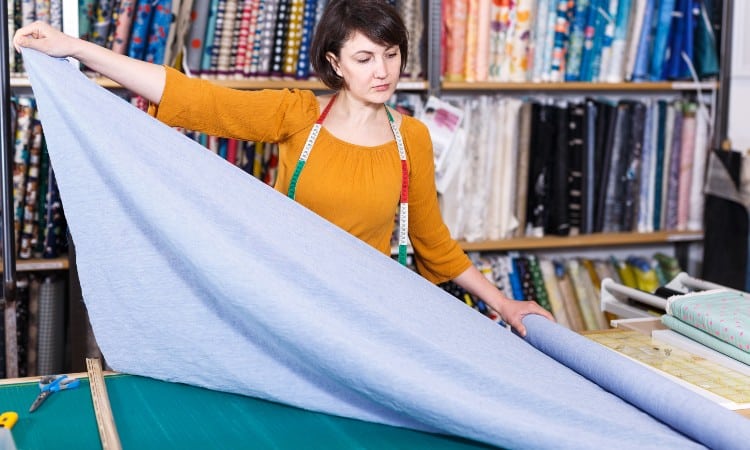
How Much Fabric Do I Need?
It's important to gauge how much fabric you'll use in a project. There's nothing worse than reaching the halfway point of a task to find you can't finish it.
The return trip to the store to buy more supplies is distracting, inconvenient, and will have a befuddling effect on your brain. You'll lose more than just time, you'll lose track of where you are in the project. Having to rethink what you were doing when you get back will put a big dent in your incentive to complete your project.
To avoid the drain on your productivity, what do you need to focus on to make sure you get the right amount of fabric?
Different Projects require Different Amounts
The amount of fabric you need depends on the type of project you're planning. From clothing to upholstery and home décor, each project is unique.
As well as requiring different amounts of fabric, you'll find the type of fabric will be different too! Chairs need a heavier, durable material whereas blouses need lighter weight fabrics.
Each style or type of fabric comes on a particular sized roll or bolt. For curtains, you could be looking at a roll measuring over 100 inches in width. Fabric for clothing, on the other hand, comes on bolts or rolls from 36 – 60 inches wide.
The wider the fabric, the less you need. Your project and the style of fabric will have a huge effect on how much you need.
How Big Is My Project?
It sounds a little obvious but, have you sat down and thought about the project you are undertaking? How big is it?
Accurately assessing the amount of fabric you need relies on you knowing the true size of what you are trying to do. Let's say you want to smarten up your living room by rejuvenating the tired old threadbare sofa with fresh, vibrantly colored fabric.
The first thing you need to measure is the sofa's cushions. They are box-shaped so each one has a top, bottom, and sides. Then you need to consider the arms, the base, the back…
There is so much to measure in a sofa; it's easy to forget something. Also, remember the rest of the room. How will the revived sofa fit in with your décor? Your armchair, for instance. Does it need new covers to match? What about your throw pillows?
Whenever you are working with fabric, you need to remember the hidden aspects of sewing. Things like seam allowance, pleats, gathers, and hems.
Most modern commercial patterns include an allowance for sewing the fabric pieces together and finishing edges. If you use your own self-drafted pattern though, remember to add extra space for seams, hems, and decorative finishes to ensure the item fits.
Also consider pattern matching. This is where you arrange the fabric at the seam line, so the pattern on the fabric is continuous. Making the seam almost invisible. Matching patterns or bold prints successfully requires more fabric than the sewing pattern recommends.
Before you think about fabric and the yardage needed, plan your intended project. What does it entail? Once you understand the size of your project, you'll be able to gauge your fabric requirements.
Why is it Better to Have Extra Fabric?
One of the main reasons for making sure you have plenty of fabric is the color of the dye. Bolts or rolls of fabric are made in lots. Each lot will use the same dye.
The color of the dye can change from one batch of fabric to another. If you have to buy more fabric, you run the risk of an obvious color change. You might think it's the same hue in the store, but when you get home, the difference could stand out like a sore thumb. Especially if you can't hide the change in an inconspicuous area.
Another reason is making errors. Fabric cutting, in particular, is one of those areas that trips us all up. Having spare fabric to hand when you've been a bit liberal with the scissors is a great way to save your sanity.
While it's true accurate calculations lead to a leaner, budget-friendly project, allowing wiggle room with extra fabric, could work out more economical in the long run.
It may seem a little extravagant at first but it saves you the horror of running out of fabric and not being able to find more. Besides, you can use the leftovers to make matching throw pillows, fashion accessories, or other small projects. Win win!
How Big Is A Yard of Fabric?
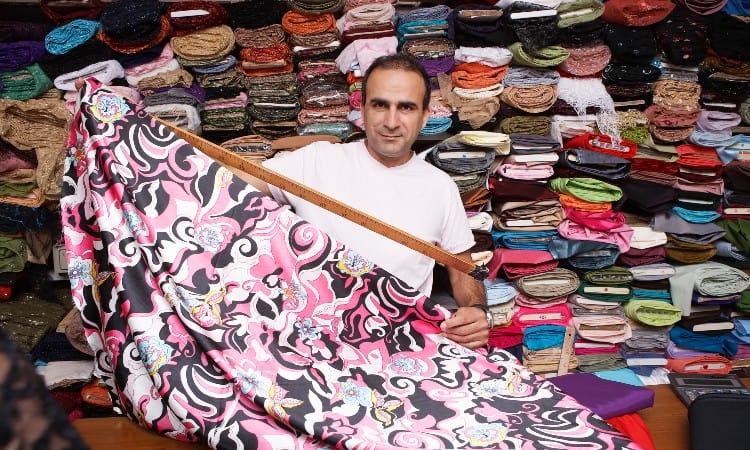
Fabric can come in a range of widths suitable for different projects. Material with a width of 110 inches, for instance, is ideal for larger tasks. Quilters' cotton tends to be around 45 inches wide. Fabric for clothing can be a variety of widths from 36 inches to 58 inches. When it comes to fabric width you're spoiled for choice.
A yard of the fabric refers to the length of the material. Whether you buy fabric for clothing, upholstery or bedding, the length will always be measured in yards, or if you use the metric system, meters.
How much fabric you get in that yard depends on how wide your chosen material is. For example, let's use a width of 60 inches. If we use feet to make calculations a little easier, 60 inches is equal to 5 feet. A yard is the same as 3 feet. Multiplying the two together (5ft x 3ft), gives us 15 square feet of fabric. This is the surface area.
A shorter width of fabric will give you less surface area so your yard of fabric, although the same length, will be smaller overall. See our article How Big Is A Yard of Fabric for more information.
How to Calculate Fabric Yardage
The first place to start calculating fabric yardage is with the dimensions of your completed project. Remember to factor in the item's intended purpose.
Curtains, for instance, are cut bigger than the window to allow for an overhang on each side. It helps hide the wall around the window, giving a smooth and neat finish. Now you have accurate measurements, you can focus on your fabric choice.
Next, calculate how many pattern pieces fit in the fabric's width. If your pattern has five pieces but only two fit across the width, you need to buy more yards to accommodate the remaining three pieces. You'll need three rows of pattern pieces along the length of your fabric.
Finally, using the height of your tallest pattern piece, measure the length of fabric you'll need to comfortably fit all your pieces. For the previous example, let's use 12 inches as the height of the tallest pattern piece. You need 3 rows, so multiplying 12 by 3 gives 36 inches. The minimum amount of fabric for this example is one yard.
Allowing for extras like seams, hems, and ease, let's say the length comes out at 1.5 yards. Always round up to the next whole figure. For this example, you'd need 2 yards.
If you are using a fabric that needs to be pattern matched, measure the pattern repeat and add that amount to the yardage. If the repeat is 6 inches lengthways and 6 inches across the width, add the two together to get 12 inches. Multiply this by the number of pattern piece rows. This gives an additional 36 inches of fabric for matching. Your total fabric requirement is now 3 yards.
How Does Fabric Type Effect Yardage
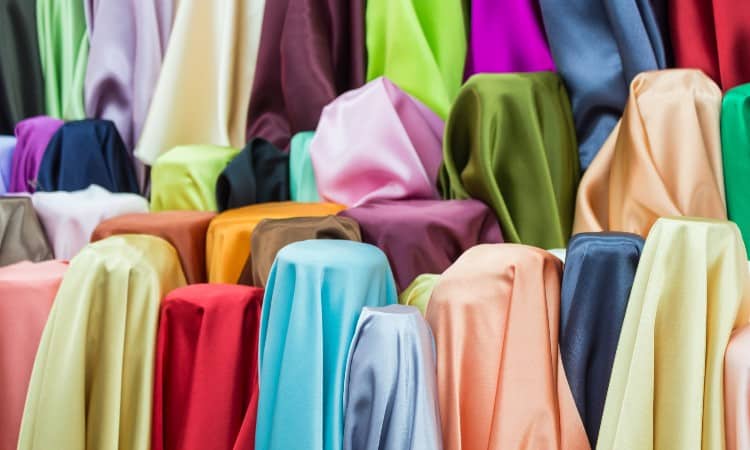
Fabric is available in a range of types, styles, and widths. There are several differences between one style of fabric and another. Your intended project will determine which material you choose and how much you buy.
Stretch fabrics
Some stretch fabrics, especially those used for leisure or activewear, can be cut with negative ease. Because of the stretch properties, you can use less fabric than your body measurements would normally require.
The material is designed to stretch in 4 directions so doesn't need the same volume as other fabrics. This feature is instrumental in the close-fitting nature of garments made from the fabric.
Knit fabrics
Similar to activewear materials, knit fabrics also have a certain amount of stretch. There are several different types of knits, each with a different degree of stretch capabilities. Jersey knits, sweater knits, and Ponte de Roma are examples.
As these fabrics are knitted rather than woven, they have a natural 2-way stretch. This gives the garments made with them, a looser, comfortable feel.
Although most knits need some ease, it is greatly reduced when compared to woven fabric. This means you can buy less fabric, depending on how loose or tight-fitting you want your clothing.
Woven fabrics
Woven fabrics are made from weaving together threads going lengthways and widthways. Otherwise known as warp and weft threads. This makes a tight, sturdy fabric with limited stretch.
Cotton and linen are examples of woven fabrics. Although they can be woven with Lycra to give a little more stretch, these fabrics tend to be more rigid. This rigidity can create the classic tailored look of fitted shirts, jackets, and dresses.
Because of their sturdy, non-stretch properties, garments made from woven fabrics must allow for ease and fasteners, like buttons or zippers.
Upholstery
Upholstery fabric is the name given to the heavier fabrics used for covering furniture like sofas. These fabrics have the same properties as woven fabrics. You will need to purchase extra for pattern matching and ease.
Leather
Leather is a hardwearing natural fabric made from animal skins. With only a small amount of stretch, it is another fabric that needs an extra allowance for ease. Imitation leather or pleather has the same properties.
How Many Yards of Fabric Do I Need?
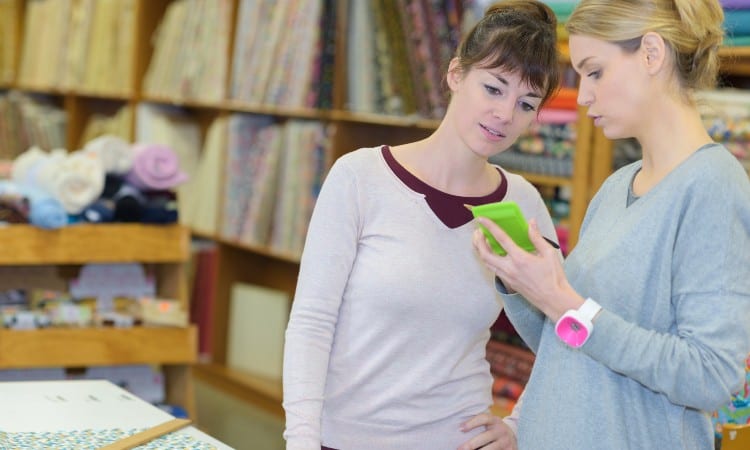
For commercial patterns, fabric yardage for clothing and some home décor projects is written on the back of the packet. You only need to add extra fabric to pattern match something like a bold print, tartan, or a stripe. Other things like seam allowance, special effects, and trims, are all included in the pattern details.
But, what if you are making your own design from scratch? What do you need to include to make sure your self-drafted pattern will have enough fabric?
The first thing to remember is everyone has different body measurements. Make sure to measure yours carefully and accurately. You'll also need to consider the garment you are making. Are you looking for a close, figure-hugging fit? Will it need gathers or other fabric hungry embellishments?
Width of your chosen fabric will also affect the final yardage amount. As will the need to pattern match. There are a few ballpark figures available for many garments to give you a starting point. Let's take a look at some of the more popular ones.
Yards Needed For a Dress
 The rule of thumb for dress fabric is you'll need enough yardage to cover twice the length of the dress. If you have a dress design measuring 36 inches or one yard from the front neckline to the front hem, you'll need the same again to cover the back.
The rule of thumb for dress fabric is you'll need enough yardage to cover twice the length of the dress. If you have a dress design measuring 36 inches or one yard from the front neckline to the front hem, you'll need the same again to cover the back.
For this example, the minimum would be two yards. That's a starting amount though. Remember to add extra inches for seams and hems. Then there are the sleeves, collars, facings, and pockets. Don't forget sleeves come in short, long, or three-quarter lengths. Even the sleeve style can add or remove a yard.
Dresses of an average length are estimated to use about 3 yards. This will change depending on the style of dress. A dress with a circle skirt will need more yardage. Prom dresses, depending on the style may need even more. You could be looking at over 5 yards.
Your individual measurements and requirements in a dress may also increase or decrease these figures. It's important to estimate your fabric needs based on your own dimensions.
Yards Needed For a Skirt
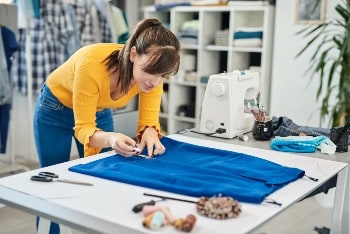 Skirt fabric requirements are based on the amount of flare in the garment. They also rely on the width of the fabric. A fabric piece with a width of 36 inches and a length of 2 yards, might be just enough for a short pencil skirt. But, you still need to allow for seams, hems, and decorative touches.
Skirt fabric requirements are based on the amount of flare in the garment. They also rely on the width of the fabric. A fabric piece with a width of 36 inches and a length of 2 yards, might be just enough for a short pencil skirt. But, you still need to allow for seams, hems, and decorative touches.
Similarly, as with the dress, gathers, pleats, and the style of the skirt will alter the amount of yardage you need. As will design features like darts.
For a flared skirt you'll probably be looking at closer to 5 yards. Or more, depending on how flared or how long you want the skirt to be. Style is a large factor when it comes to fabric requirements for skirts.
Yards Needed For Pants
Fabric for pants can vary depending on the size of the person. On average, you are looking at twice the length to cover the front and back, and an extra amount for crotch, pockets, waistband, hems, and seams. Anywhere in the region of 2 to 3 yards is a good starting point for pants.
Yards Needed For a Shirt
Shirts can be made using about 3 yards of fabric. It all depends on the size of the person and the length of the shirt and sleeves. Fabric width will also change the yardage amount.
Full sleeved shirts
36 inch wide fabric – 7′-10″ or 2.40 meters
58 inch wide fabric – 5′-3″ or 1.60 meters
Yards Needed For a Jacket
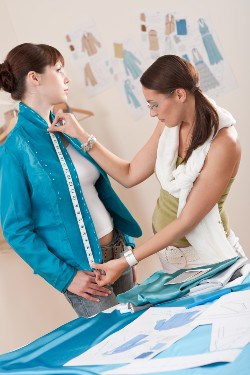 Jackets have a lot of intricate design features that need to be considered. Things like button plackets, lapels, collars, and linings. If it's a tailored jacket, you'll probably have welt pockets, and facings. Then there is the length of the jacket itself.
Jackets have a lot of intricate design features that need to be considered. Things like button plackets, lapels, collars, and linings. If it's a tailored jacket, you'll probably have welt pockets, and facings. Then there is the length of the jacket itself.
All the added elements add to the fabric requirements. So does the choice between a jacket for a man, woman, or child. For an average adult-sized, blazer style jacket, you'll be looking at a minimum of 2 yards.
If you want the jacket lined, even if you're using a different fabric, fabric needs will double.
Yards Needed For a Suit
Fabric for a suit will differ if it's a man's 3-piece suit, or a woman's pants or skirt suit. Each different garment within the suit will need to be measured according to the recipient's dimensions. As suits tend to be formal, considerations should also be given to tailored features such as lapels, welt pockets, and the lining of jackets. The actual requirements are assessed using the same guidelines as the jackets, pants, and skirts above.
Yards Needed For a Pair of Curtains
To gauge the fabric needed for curtains, you need to measure both the height and width of your window. The width measurement should match or be larger than your curtain pole. Extra width allows for a pleating effect.
Curtain length is known as the drop. Your fabric needs to be as wide as possible or you will have to buy extra yardage to join lengths together. Fabric requirements are drop multiplied by width. Remember to allow extra for hems and any seams.
Fabric Yardage Calculator
To make life easy when it comes to deciding on fabric needs, you can use a fabric yardage calculator. Available for a multitude of projects, from clothing to upholstery, a fabric calculator can take the headache out of fabric buying. Simply enter your project dimensions and let the fabric calculator do the math for you.
Conclusion
When it comes to fabric, the amount you buy depends on the project, fabric type, and width. As a rule of thumb, it's better to overestimate than try to buy the exact amount. That way, you'll have wriggle room for errors. Besides, you can use the leftovers for matching accessories or even throw pillows.
Leave a comment to let me know if you liked the article. Did it help you work out how much fabric you need? How do you feel about buying fabric? Do you have a favorite fabric yardage calculator?
Source: https://silverbobbin.com/how-much-fabric-do-i-need/
0 Response to "Amount of Fabric Needed for a Dress is 2 5 Yds Discrete or Continuous"
Post a Comment